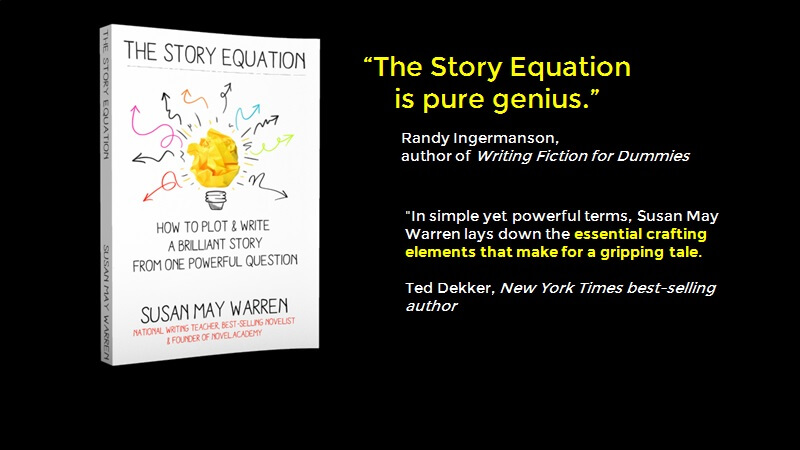Tammy Barley is an award-winning, best-selling author, manuscript editor, and top fiction contest judge. Her clients have won writing awards, series publishing contracts, five-star reviews, and have appeared with their books on Fox News, CBS, and countless radio shows. Visit her website.
NJ: Tammy is giving away a copy of her new Western romance novel, Hope’s Promise, book two of The Sierra Chronicles trilogy. No mad scientists, but plenty of tough guys, suspense, and touches of inspiration. To be entered in the drawing, leave Tammy a comment.
In-Skin POV:
It. Is. Alive!
Steel-gray smoke curled from the charred torso of Dr. Frankenstein’s monster. No. Not monster—creation.
Victor released the platform-lowering wheel and stepped away from the stone wall. He inched forward, his anxious hands reaching out for the scorched metal table and for the still, smoldering form that lay upon it. Above, wicked lightning flickered down through the open ceiling of the laboratory—gnarled fingers beseeching the creation to live.
As Victor watched the massive arm nearest him for movement, he climbed the platform, then pressed the side of his face to his creation’s chest. He listened, but heard no heartbeat, save the increasingly fearful thrumming of his own. Against his cheek, he felt only the cool, exanimate stiffness of clay. His creation’s chest did not rise; its lungs did not breathe. The carotid artery in its neck did not twitch, but remained flat around coagulated blood.
Desperation crawled up the back of his neck on cold, sharp little rat claws. Victor stood and backed away. The hulking corpse lay before him as dead as it had been when he first pried the lid from its coffin. Motionless. Lifeless.
Final tendrils of gray vapor rose from the body, then thinned and dissipated.
Then, his creation’s bare chest rose. The artery in its throat began to pulse.
Most writers are familiar with deep POV, a technique we use to reveal a character’s observations, thoughts, reactions, and feelings. I’ve developed a new technique with which to explode deep POV into three-dimensional, full-color-spectrum life: I call it in-skin POV.
“Deep” POV allows the reader to see the story, as if a Hollywood film is playing before him. In-skin POV enables the reader to BE the main character, to be transported to the place and time you’ve created, complete with explosions in surround sound, flying debris that your reader is forced to duck, and acrid smoke that stings his nostrils.
Here are three ways to deepen “deep” POV, and to place your reader into your character’s skin:
1. BE the character as you write. Feel his clothes, belt, boots, and hat. Feel the weight of his gun against your hip. Feel the sun’s sizzle through your sleeves, and on the backs of your hands. Feel the thick mud sucking at your boots. Is he tall? Stand on a stool and gain his perspective. Is he being held captive? Bind your hands and feet with scratchy ropes and lie on your basement floor awhile. Is your heroine dizzy from running? Spin around in your office chair until you’re dizzy, and record your observations, in order, as they come to you. Scatter these in-skin observations and sensations throughout your book. What you experience as you write, the reader will experience as he or she reads.
2. Use the five senses. Let the reader see, hear, feel, smell, and taste often, though not during scenes which require a fast pace. Used well, the five senses will make scenes leap to life, which will make your book unforgettable.
There’s not room to discuss all five senses in detail here, but I’ll show you how you can use The Sense of Touch:
This is the best of the five senses you can use to enable the reader to feel that he is in the skin of the POV character. Touch can have temperature—feverish, hot, warm, cool, cold, icy. It can be dry or moist. It can be rough or smooth. Touch can be feathery light or strong as an iron clamp.
Touch can evoke emotion, and so a touch can be eager, passionate, hurried, slow, sensual, frantic, giving, demanding, threatening, calming, soothing, empowering. Touch can involve temperature, texture, amount of pressure, and emotions, and usually prompts a reaction in the character receiving the touch. Write and rewrite the touch until YOU feel it. If you feel the uniqueness of the touch, the reader will feel it, and, like the character recipient, will respond to it.
Touch can also be observed, and can cause the character who views the touch to react and to draw conclusions about the personality and intent of the one he or she is observing. For example, one character can observe another gingerly nosing a knife into a wound to remove a bullet from a mutual friend. A different character can grip a switchblade in his fist and emerge from the shadows of an alley.
Use the sense of touch in unique ways to add vivid realism.
3. Put events in the order they occur. For fiction to be as real (and therefore as immediate) as possible, put events in the order they occur. For example, Lori can’t analyze the tone in Jessica’s voice BEFORE Jessica even speaks, just as we can’t analyze the tone in someone’s voice before they speak. First we hear the words, then we think, “She said that in disbelief,” or “He sounded annoyed.” When you describe how a voice sounded before the dialogue is spoken, it is a narrator (the author) telling the reader information about what is taking place, rather than the POV character revealing to the reader through the character’s thoughts what is taking place. When done often, this “narrative telling” distances the reader from the story, and the book become just that—a story. The realism is lost.
You can also apply the technique “put events in the order they occur” to actions: Pete strode into the warehouse and slammed the steel door behind him. Not: Pete slammed the door behind him after entering the warehouse. Act out a scene if you need to, one small step at a time.
When you put events in the order they would occur during a real life scenario, the events will unfold, live, around the reader, and they will experience them inside the POV character’s mind and skin.
Read the Frankenstein passage again, and analyze how each of these three techniques is applied. Use in-skin POV in your own writing, and your creation will leap to life.
Jake Bennett is finally wed to the love of his life, Jessica Hale—but he isn’t convinced she won’t leave him. Life is a constant struggle for the Bennetts as they battle drought and live in fear of raids on Southerners, and he is not sure that Jess knew what she was getting herself into when she married him.
Jess, however, despairs for another reason—she is unable to conceive a child.
While trying to prove their unconditional love for each other, the Bennetts must defend against attacks on the Paiutes, the doubts that haunt them both, and an unknown force that threatens to destroy all they hold dear. Together, they must stand in faith through betrayal, barrenness, and a very real threat, trusting that God will reward their hopes for a better future.

























I came from Tammy's newsletter. I hadn't known so much about POV, but it always fascinates me to see how meticulous authors write their work. It would seem the easier a book flows that you just forget that there was even a method. gasweetheart211[at]netscape[dot]net
ReplyDeleteHi, Adge! I'm delighted to see you here! (Actually, when you're writing about a man like Jake Bennett, it doesn't take much effort.) =)
ReplyDeleteTammy
Oh, don't forget to enter to win a vacation! Visit http://www.tammybarley.com/Bookshelf.html for details and to enter!
ReplyDeleteGREAT stuff here. THANKS for this. :-)
ReplyDeleteGlad to. We are entertainers, no?
ReplyDelete=)
Great post. Simple, yet profound! I hope no one gets hurt while "experiencing" a scene they are about write. It could be dangerous if you character is involved in a car accident!
ReplyDeleteLOL! Obviously, keep safety in mind. However, should you get into a car accident, you'd have one more gripping experience to write about.
ReplyDelete=)
Great post! I love the tips. "Being" the character is something I already try to do, but you've inspired me to do more. My kids will just have to add my strange "in character" actions to their weird-things-Mom-does-while-writing list. ;)
ReplyDeleteLOL! My kids love my job. Especially when they "have" to taste new chocolates from around the world so that I can introduce a new "Chocolate of the Month" in my newsletter Lassos -N- Lace.
ReplyDelete=)
I sometimes forget to use deep POV during the initial writing especially when I'm flying along. Then I don't stop long enough to savour a particular experience the character is having. But getting into the character's skin makes the writing much more fun. Thanks for the reminder to slow down and get more involved.
ReplyDeleteIn my writing life, I live in the world of nonfiction (so far). When I teach other writers, I preach the importance of personalizing our messages--letting readers see, feel, smell, taste, hear as we do--to build their connection with and involvement in what we write. Your piece helps me understand the same concept from a fiction-writing perspective. Thanks!
ReplyDeleteI gave a workshop on deep POV yesterday and included a lot of what you said about getting inside your character to let the reader see, feel, and experience exactly what the character is. You've added some additional pointers that will help me even more. That's the part of revision I love...going deeper into my character and giving them life. Thanks for the tips.
ReplyDeleteHi, Carol! You nailed it--writing in-skin POV is as fun an experience as reading it. Whatever the writer experiences--whether it's laughter, tears, or the jolt of the hard ground when the character tumbles off a horse--the reader will feel it too.
ReplyDeleteMarti, you are so wise. I teach the five senses as one of the most important techniques a writer can employ for powerful realism, though that concept initially took me awhile to figure out. =)
Thank you, Martha, for the revision tip!
I just received my copy of this book. Thank you Tammy! Now I want to read the whole series, which looks great. Nice to see this interview here! God bless and keep you!
ReplyDeleteMy pleasure, Carrie! God bless you too. =)
ReplyDeleteGrea info!!
ReplyDeleteThank you, Martha! I hope it's helpful. =)
ReplyDeleteI'm a reader with no writing ability whatsover, but I enjoyed the POV article. Kind of reminds me of composition class in college, which I struggled with. Now I know why certain books hold more appeal than others.
ReplyDeleteI enjoyed your first book very much, Tammy, and look forward to the other Sierra Chronicles books. Thank you for the chance to win Hope's Promise.
cjarvis [at] bellsouth [dot] net
Hi, Carole! I'm so delighted that you enjoyed the first book. Yep, I know what you mean about abilities--I can't sing, play an instrument, or paint, but I still love many kinds of music and art. =)
ReplyDelete